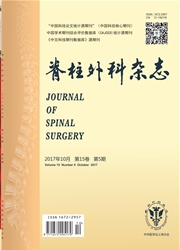

 中文摘要:
中文摘要:
目的探讨Bryan人工颈椎椎间盘置换术(artificial cervical disc replacement,ACDR)治疗颈椎椎间盘突出症的中长期临床疗效及并发症发生情况。方法回顾分析13例颈椎椎间盘突出症患者,采用Bryan ACDR治疗,单节段11例,双节段2例,共置换了15个节段。术后定期随访,依照Odom评级和日本骨科学会(Japanese Orthopaedic Association,JOA)评分评定临床疗效和神经功能改善情况,通过影像学资料观察假体位移、假体周围骨吸收、异位骨化、假体活动度及颈椎生理曲度变化。结果经过5年以上的随访,患者神经症状有明显缓解,Odom评级临床优良率达到92.3%J,OA评分由术前的11.6分增加到的15.6分。术后X线片示假体稳定,没有出现假体前后位移〉2 mm。术后1例出现自发性融合;1例在置换节段上位椎体前下缘有明显骨吸收,接近2.5 mm,并伴椎体后缘的异位骨化。末次随访时置换假体活动度平均为9.2°,邻近节段活动度与术前相当。结论通过5~7年的中长期随访,Bryan ACDR术治疗颈椎椎间盘突出症具有较好的临床疗效,并发症少,安全可靠。
 英文摘要:
英文摘要:
Objective To evaluate the mid-long term clinical efficacy and complications of Bryan artificial cervical arthroplasty replacement(ACDR) for treatment of cervical disc herniation.Methods Thirteen cases of cervical disc herniation were retrospectively analyzed.A total of 15 sets of Bryan cervical disc prosthesis were implanted into 13 cases,including single level disc replacement in 11 cases and bi-level in 2 cases.During follow-up,the clinical efficacy and neurological function were evaluated by Odom's criteria and Japanese Orthopaedic Association(JOA)score;the mobility,resorption,heteropic ossification,physiological lordosis and range of motion of the implanted and adjacent segment were observed on dynamic radiograph.Results After more than 5 years of follow-up,all cases showed significant improvement in neurological symptoms,the clinical satisfactory rate of Odom's criteria was 92.3%,and JOA score was increased from 11.6 to 15.6.According to the radiograph,stabilization was achieved for all artificial disc prothesis,and no migration greater than 2 mm was observed.One case had a spontaneous fusion,and another had a resorption greater than 2.5 mm at the inferior edge of anterior surface of upper vertebral body and also had heterotopic ossifiction.The average range of motion at implanted segments was improved from 4.6° to 9.2°.Conclusion Bryan ACDR prosthesis can achieve satisfactory clinical efficacy for cervical disc herniation in mid-long term follow-up,with few complications.ACDR is a reliable and effective treatment for cervical disc herniation.
 同期刊论文项目
同期刊论文项目
 同项目期刊论文
同项目期刊论文
 期刊信息
期刊信息
